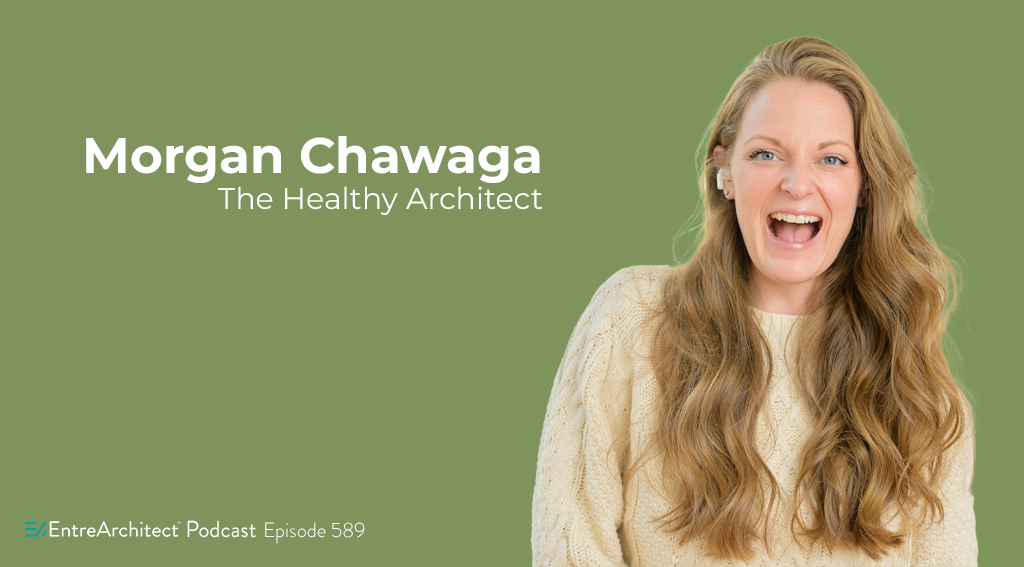
Stress and burnout have long been considered inevitable parts of an architect’s journey. From grueling all-nighters in architecture school to managing relentless client demands, architects have historically worn their stress as a badge of honor. But Morgan Chawaga, licensed architect and founder of The Healthy Architect, is on a mission to challenge this norm and redefine what it means to thrive in the profession.
In our conversation on the EntreArchitect Podcast (Episode 589), Morgan shared her personal journey, her insights into the root causes of stress and burnout, and practical strategies for architects to build healthier, more balanced relationships with their careers.
The Journey from Architect to Advocate
Morgan’s story began with a love for creativity, heavily influenced by her father’s career in construction. After earning degrees in architecture from the University of Kentucky and the University of Pennsylvania, she navigated various roles, including as an owner’s representative and a director of marketing for architecture firms. Each step revealed unique insights into the architectural profession’s demands—and its vulnerabilities.
Through these experiences, Morgan noticed a recurring theme: architects are exceptionally talented but often their own worst enemies when it comes to managing stress. This realization, paired with her own encounters with burnout, drove her to create The Healthy Architect, an initiative dedicated to addressing the chronic stress and systemic challenges facing architects.
Burnout: A Hidden Epidemic
Burnout, as Morgan explains, isn’t merely about feeling overworked—it’s a complex phenomenon with three distinct dimensions:
- Physical Burnout: Chronic fatigue and energy depletion.
- Emotional Burnout: Feelings of cynicism, detachment, and negativity.
- Overwhelm: An overload of sensory and informational input, leading to paralysis.
She noted that many architects don’t even realize they’re burned out because it has been normalized within the profession. “It’s not okay,” Morgan asserts, “and it doesn’t have to be this way.” Chronic stress, often unaddressed, leads directly to burnout and impacts not only professional efficacy but also relationships, health, and quality of life.
Understanding the Stress Cycle
One of the key concepts Morgan teaches is the stress cycle—the biological process our bodies undergo when responding to triggers. While most architects are adept at managing the immediate response to stress (such as an urgent email from a contractor), they rarely close the loop by signaling to their bodies that the stressor has passed.
Failing to close the stress loop leaves architects perpetually in a heightened state of stress, which can snowball into chronic stress and burnout. Morgan emphasized the importance of integrating simple, evidence-based practices into daily routines to manage and mitigate this stress.
Practical Strategies for Stress Management
During our conversation, Morgan shared several actionable strategies for reducing stress and fostering resilience:
- Breathwork: Morgan introduced a simple yet powerful breathing exercise to help architects close their stress loops. By intentionally focusing on deep, controlled breaths, you can calm your heart rate, improve oxygen flow to your brain, and regain clarity during high-pressure situations.
- Digital Detoxes: For those experiencing overwhelm, taking intentional breaks from technology can be transformative. Morgan recounted how she and her clients practiced brief moments of silence—whether during a commute or in a parked car—to reset their minds before transitioning between work and home.
- Creating Commutes at Home: With many architects now working from home, the natural boundaries between work and personal life have blurred. Morgan recommends creating a “commute” ritual, such as a short walk outside or a designated shutdown routine, to mentally transition out of work mode.
- Micro Habits: Small, intentional habits, like sitting in silence for two minutes or journaling the next day’s priorities, can have a profound impact when consistently practiced over time.
Shifting the Culture of Architecture
Morgan also highlighted how deeply ingrained cultural norms perpetuate stress in the architecture profession. From the all-nighters of design school to the glorification of overwork in professional practice, architects are conditioned to view stress as an unavoidable aspect of their identity.
“The architects of the future,” Morgan said, “will no longer normalize burnout or chronic stress. They will design and build healthier relationships with their careers.”
This cultural shift begins with education. Morgan’s workshops and master classes provide architects with the tools and knowledge they need to manage stress, prevent burnout, and create sustainable work practices.
A Holistic Approach to Wellbeing
The Healthy Architect goes beyond stress management by embracing a holistic approach to wellbeing. Morgan envisions a future where architects have access to a network of professionals, including nutritionists, therapists, and burnout prevention coaches. These resources, she believes, are essential for architects to thrive both personally and professionally.
Nutrition, sleep, and mental health aren’t just individual concerns—they directly impact the quality of the architecture we create and the built environment we shape. By prioritizing their own health, architects can elevate their work and contribute to a better, more sustainable future.
Taking Action Today
Morgan’s advice to small firm architects is simple yet profound: take action. Whether it’s enrolling in a master class, experimenting with stress management techniques, or reaching out for one-on-one coaching, the first step is often the hardest—but also the most critical.
Architects don’t have to accept stress and burnout as inevitable. With the right tools, mindset, and support, they can redefine success on their own terms.
Join the Healthy Architect Movement
The future of architecture is healthy, and Morgan Chawaga is leading the charge. To learn more about her work and access resources to support your journey toward a healthier, more balanced career, visit TheHealthyArchitect.org.
As Morgan aptly put it during our conversation: “It is 2024, and we are way behind. But together, we can build a future where architects no longer see burnout as normal but as a call to action.”
Let’s take that action today.
This article serves as an invitation to architects everywhere to embrace a new paradigm of health and wellbeing. For more insights, listen to my full interview with Morgan on the EntreArchitect Podcast, Episode 589, at EntreArchitect.com/589.

Leave a Reply